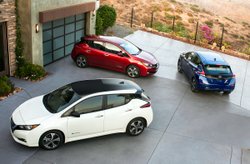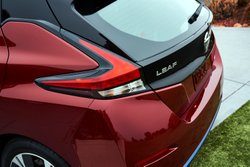More Dynamic Design, More Range & Tech, Cheaper Price
The 2018 Nissan Leaf was unveiled to the world today and it marks a strong competitive move in a market full of new rivals. Context is everything. Leaf 2.0 launches in a world with two key competitors that have shaped Nissan’s flagship eco-car. The Chevrolet Bolt has been on the market since December. While not tearing it up in sales, it has sold steadily (and outsold the Leaf) this year and this month is available across the U.S. Last month the first of Tesla’s Model 3 rolled off the line, posing another mid-market challenge (and that model has almost a half-million reservations).

Those two models frame the new Leaf’s announcement. The Bolt’s appeal is an affordable mid-$30,000 price tag with an abundance of advanced technology. The Model 3 has more cache and more of a luxury and performance appeal. Both boast 200+ mile ranges in entry-level models.
The 2018 Nissan Leaf undercuts the price of both the Bolt and Model 3, sacrificing the extended range of both of those models, but strives for an image aligned on one hand with performance and the other with technology. Looking more like a performance sedan than the upright, pragmatic design of the original Leaf, the 2018 model will start at $29,990, below the price of the 2017 Leaf.
Although the Leaf model introduced in Japan touted a 400 kilometer (250-mile range), the U.S. model only claims 150 miles. That’s still twice the range of the 2010 Leaf. The new model will have Nissan’s ProPilot autonomous technology, which will allow for hands-free freeway driving. Also added is ProPilot Park, a parking-assist app and an e-Pedal, which allows for one pedal driving (you don’t have to use the brake as lifting on the accelerator dramatically slows the vehicle. While not unique to the Leaf, having all these features on a sub-$30,000 EV is a great move forward.
The 2018 Leaf goes on sale in early 2018 calendar year in all 50 states. It will carry an enhanced powertrain compared to the previous model, improving energy efficiency and delivering more torque and power. The announced numbers for the new car are 147 horsepower (110 kW, up 38 percent from the previous generation) and 236 pounds-feet of torque (up 26 percent).
The Heart of the New EV
The heart of the car is its new battery 40 kWh design. While delivering extended range, the laminated lithium-ion cells’ packaging remains the same as the first generation battery, but has a 67 percent increase in energy density.

Nissan is also teasing a “high-performance” version of the Leaf for next year.
The 2018 Nissan Leaf’s exterior design takes it out of the realm of the quirky and makes it closer to a mainstream sedan. The front end adopts the corporate Nissan look while overall the shape is closer to a sport sedan. The new model now has a Cd (coefficient of drag) of .028. It retains the functional hatchback and appears to have similar interior dimensions to its predecessor, though with an interior with more luxury aspirations.
When the Leaf become the first mainstream EV on the market in 2010, the automotive world was quite different. As the model moved through the years to become the best-selling plug-in car in the world (almost 300,000 sold), times have changed. We can’t wait to get behind the wheel to get a better feel for this second generation EV.
Here are some stats to compare with those offered by Tesla for its Model 3.
Vehicle Dimensions
Wheelbase: 106.3 inches (compared to Model 3’s 113)
Overall Length: 176.4 (185)
Overall Width: 70.5 (73)
Overall Height: 61.4 (57)
Storage Space: 23.6 cubic feet (15)

12 thoughts on “News: Second Generation Nissan Leaf Introduced”